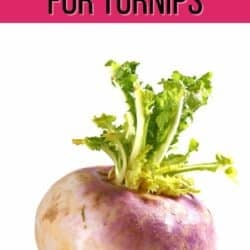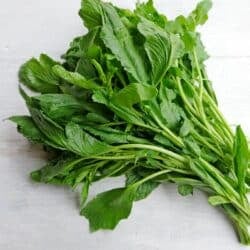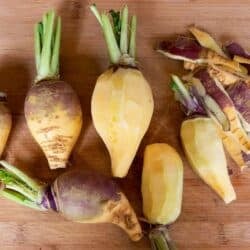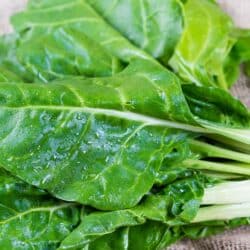8 Substitutes for Turnips (Plus How Much to Use)
If you need turnips in a recipe, but don’t have any on hand, you’re in luck! There are many great substitutes that can give your food that same delicious flavor, nutrition, and texture. Here are some substitutes for turnips including rutabagas, celeriac, parsnips, parsley root, carrots, potatoes, kohlrabi, and jicama.
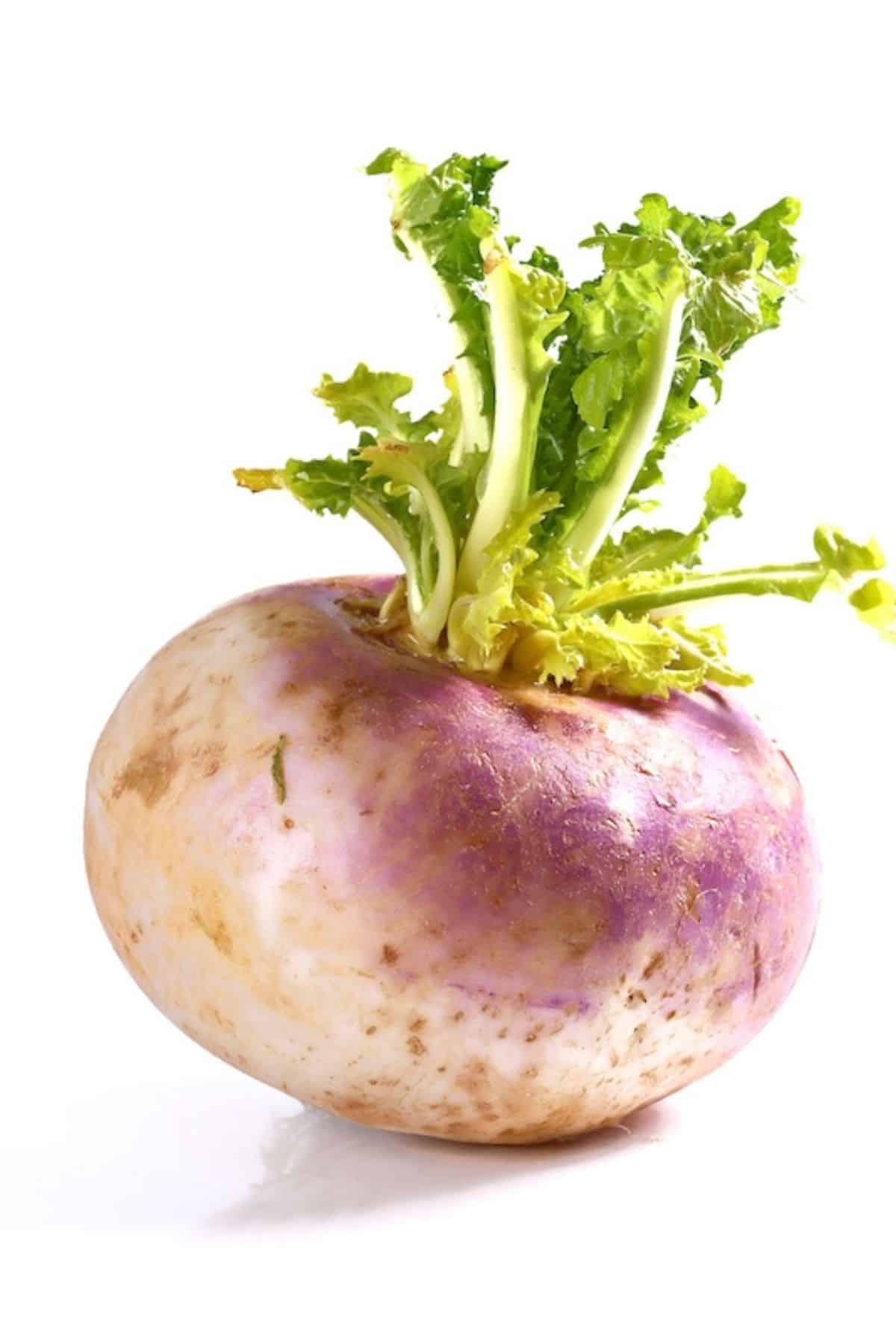
Turnips are cruciferous vegetables packed with nutrients. Part of the Brassicaceae family, they are related to kale, broccoli, and Brussels sprouts.
Creamy white in color, their skins often have tinges of purple, green, or red. Turnips are sometimes mistaken for rutabagas, but the skin of rutabagas is darker and the flesh is more orange.
Cooking With Turnips
Turnips are used in recipes all over the world. In Europe, you’ll often find them in stews and casseroles, or roasted and served as a side dish with meat. Sometimes they are called Swedish turnips.
They are a popular ingredient in Indian curries and are often used in Asian pickles, particularly the miniature “kabu” variety or baby turnips that you’ll see in Japanese cuisine.
Small, young turnips can be eaten raw, and all sizes can be cooked in a variety of ways, including boiling, steaming, and baking. They have a slightly bitter taste and crunchy texture and make a great addiction to many types of cuisines or vegetable medleys.
In the Southern United States, however, you’re more likely to encounter turnip greens, which are a favorite side served with ham hocks or bacon.
Substitutes for Turnips
Do you need turnips for a recipe but have none to hand?
Here are 8 excellent substitutes you can use in their place. You can find most of these best turnip substitutes at your local grocery store.
1. Rutabagas
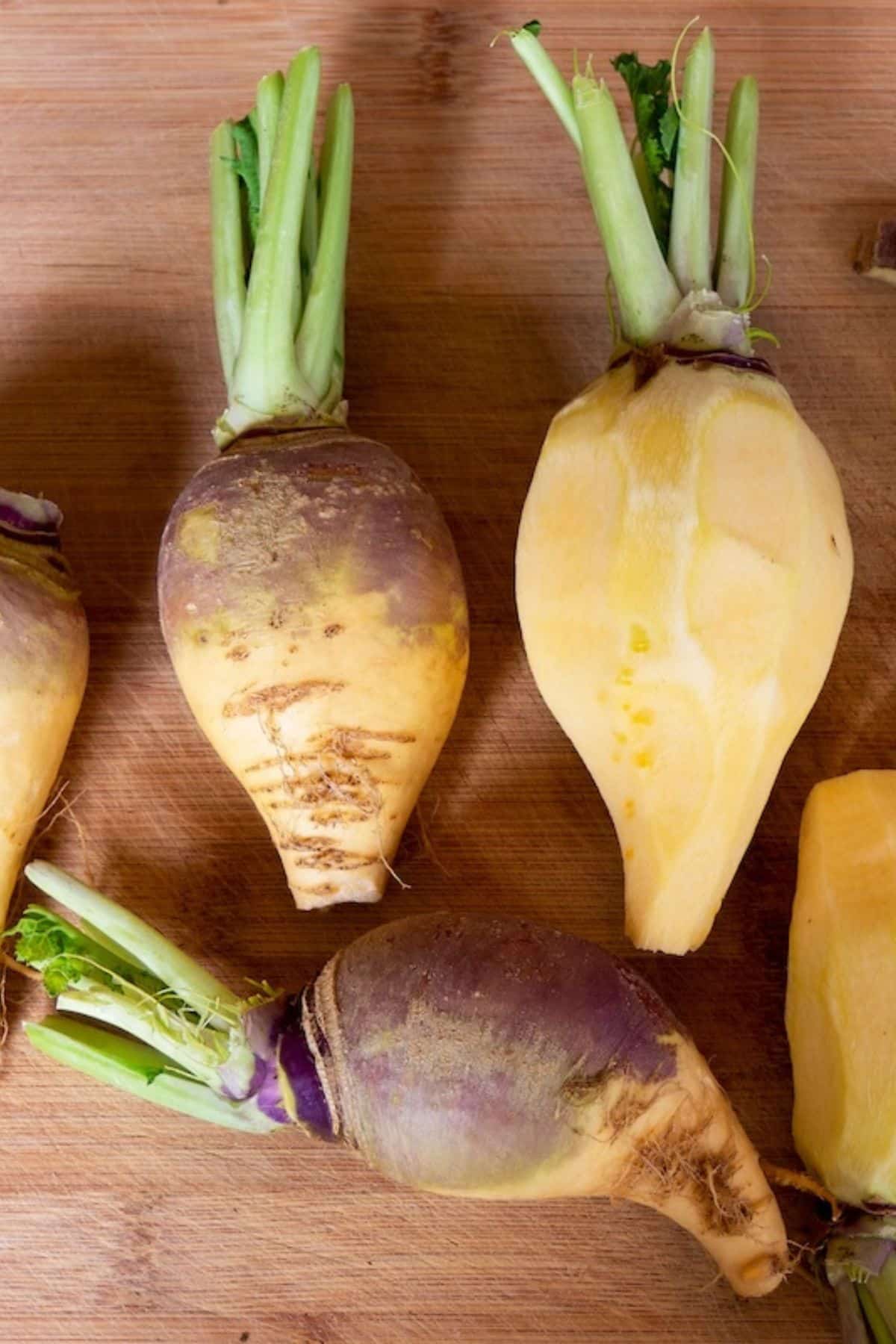
Rutabagas are my number one substitute for turnips. That’s because they are nutritious, very versatile, and can be cooked in lots of different ways. This means you can use them in almost any turnip recipe.
What’s more, they are quite similar in flavor, although there are differences.
Turnips are a bit sweeter than rutabagas, which have more of a mellow, nutty flavor when cooked. Rutabagas are also a little higher in calories and carbohydrates, so I feel they make dishes richer and more satisfying.
When buying rutabagas, you don’t need to look for small ones as you do with turnips. Unlike turnips, rutabagas are still tender when they are large.
You can roast, mash, or boil them just as you would with turnips, or use them in soups and casseroles. Just remember that they are slightly more dense, so they may take a bit longer to cook. They have a creamy texture when cooked, and a slightly earthy flavor.
You can also eat them raw, grated into salads, although some people find their flavor a little too bitter when uncooked. So, try using rutabaga as a great substitute for turnips when you’re making a cooked recipe, but not necessarily for raw turnips.
To substitute one cup of uncooked chopped turnips, use one cup of uncooked chopped rutabagas.
2. Celeriac
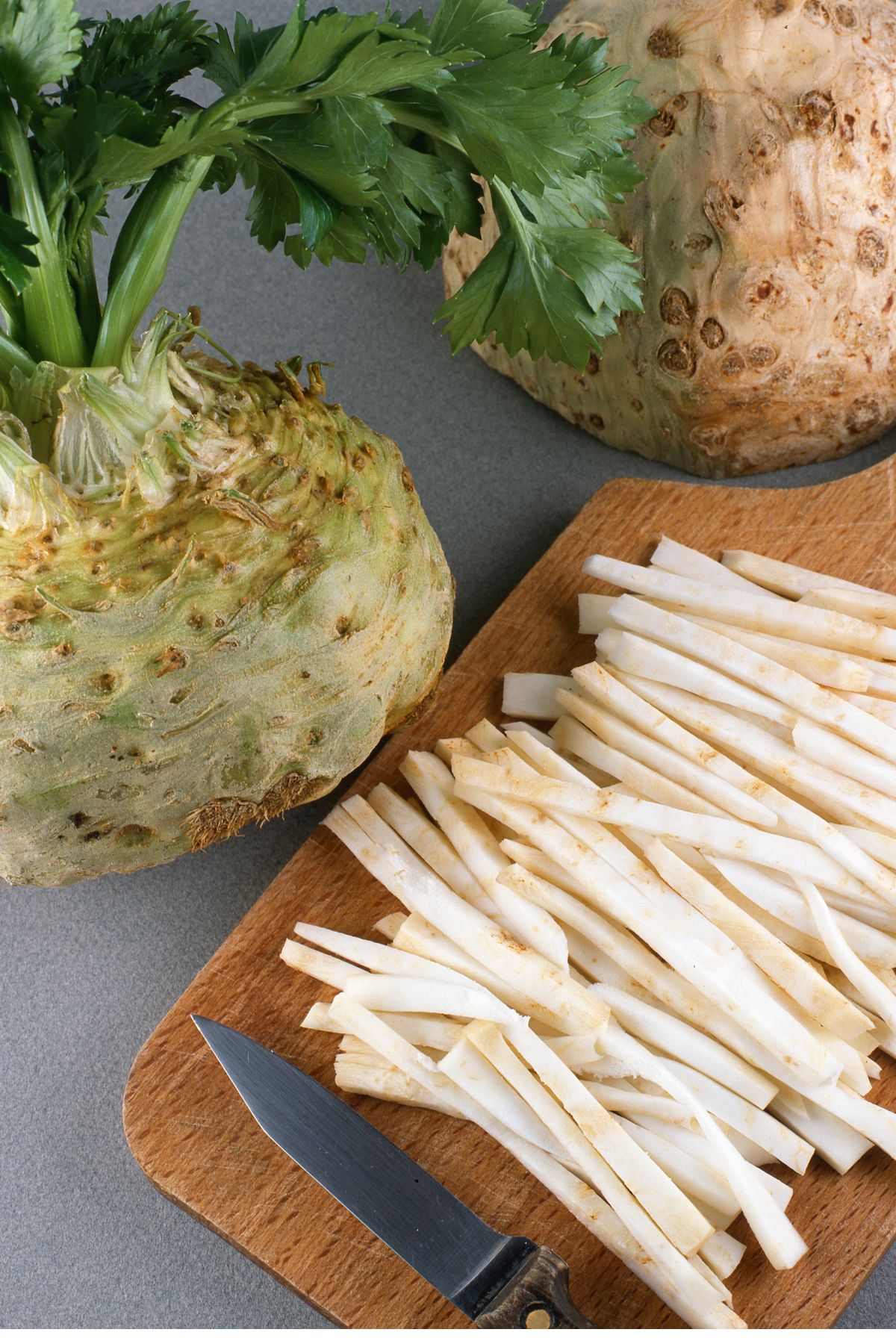
Also known as celery root, celeriac has a delicious, earthy flavor with just a hint of celery. It’s especially good in soups and stews as it soaks up the flavor of the liquid it’s cooked in.
Something to bear in mind, though, is that the texture is different and turnips are softer. Celeriac also takes a bit longer to cook.
It provides many of the same health benefits as turnips, being low in calories, high in fiber, and a great source of vitamins and minerals. Although it’s a little lower than turnips in vitamin C, its high vitamin K content makes up for that!
Just like turnips, you can roast, mash, or boil celeriac. Do remember that it adds a mild celery flavor to any dish, so make sure that will work well with your recipe.
You can also eat it raw, grated into a salad. It’s an excellent substitute.
To substitute one cup of uncooked chopped turnips, use one cup of uncooked chopped celeriac.
3. Parsnips
Carrot-shaped parsnips have a creamy, white flesh and a delicious nutty flavor with a hint of sweetness. This develops even more when they’re roasted!
Because they don’t have the slight bitterness that you sometimes encounter in turnips, you may even find you prefer them in certain dishes.
Parsnips are softer in texture than turnips, but they’re very similar in terms of nutrition and particularly rich in fiber. Since they contain more natural sugar, they’re just a little higher in carbohydrates and calories, too. They have a similar texture to turnips but more of a sweet flavor.
Use parsnips in any dish calling for turnips and prepare them in the same way. They’re very versatile root vegetables and make a delicious addition to many types of dishes.
To substitute one cup of uncooked chopped turnips, use one cup of uncooked chopped parsnips.
4. Parsley Root
This looks just like a parsnip and is the root of a parsley variety grown just for its root, not its leaves.
It makes an interesting substitute for turnips as it has a similarly earthy quality and a very unique flavor profile combining hints of carrots, celery, and parsley.
Slightly sweeter than turnips but with an almost identical texture, it works well in all sorts of recipes and can be roasted, boiled, mashed, or added to soups and stews.
Just remember to peel parsley roots first, as the skins can be a little tough.
To substitute one cup of uncooked chopped turnips, use one cup of uncooked chopped parsley root.
5. Carrots
Just like turnips, carrots are root vegetables, with the added advantage of being very widely available.
They are quite a bit sweeter than turnips, so they are better suited to recipes where this is desirable. They also have a denser texture, so be prepared to cook them for longer.
Perfect for use in any recipe calling for turnips, they are delicious raw and make a great alternative in salads. Carrots have a sweet taste and milder flavor than turnips in general.
What’s more, they’re a fantastic source of vitamin A – an important nutrient for your eyesight – although their vitamin C content is a little lower.
To substitute one cup of uncooked chopped turnips, use one cup of uncooked chopped carrots.
6. Potatoes
In a pinch, potatoes can make a good substitute for turnips. Versatile and budget-friendly, you can use them in virtually any recipe, including soups, stews, and roasts.
Just keep in mind that potatoes are more starchy than turnips, so they may cause saucy dishes to thicken. They are also less sweet, so you may want to consider adding other sweet ingredients to the dish.
Although potatoes are nutritious – rich in vitamins, minerals, and more energy-boosting carbohydrates than turnips – their calorie count is higher.
Don’t use sweet potatoes to substitutes for turnips; try to use Russet potatoes or other types of white potatoes.
To substitute one cup of uncooked chopped turnips, use one cup of uncooked chopped potato.
7. Kohlrabi
Kohlrabi may look like a root vegetable but it’s actually a member of the cabbage family.
It has a slightly sweet, peppery flavor that’s a little less pungent than turnips and a slightly firmer texture.
It’s great sauteed, steamed, roasted, or thrown into soups and stews. I also think it’s nicer than turnips in raw dishes, thanks to its milder taste and pleasant crunch!
Just like turnips, kohlrabi is low in calories and carbs, plus it offers a good array of nutrients including vitamins C and B6, potassium, and magnesium.
To substitute one cup of uncooked chopped turnips, use one cup of uncooked chopped kohlrabi.
8. Jicama
Jicama – also known as Chinese turnip – is a root vegetable with sweet, white flesh and a crispy texture.
It makes a fantastic alternative to turnips in raw recipes (just be sure to peel it first), but it stays quite crispy when cooked. For this reason, I don’t recommend it for cooked turnip recipes where a soft texture is required.
If you’re watching your calorie intake, jicama is a dream, with a higher water content and fewer calories than turnips. It’s slightly lower in nutrients but still contains some vitamin C, potassium, and magnesium.
It also provides you with inulin, a prebiotic fiber that’s great for your digestion.
To substitute one cup of uncooked chopped turnips, use one cup of uncooked chopped jicama.
Pros and Cons of Turnip Substitutes
Here’s a chart summarizing the best substitutes for turnips, including the pros and cons.
| Substitute | Pros | Cons |
|---|---|---|
| Rutabagas | Similar flavor, versatile in use. | Denser and cooks slower than turnips. |
| Celeriac | Earthy flavor, absorbs other flavors well. | Different texture, longer cooking time. |
| Parsnips | Sweeter, nutty flavor, similar nutrition. | Higher in carbohydrates and calories. |
| Parsley Root | Earthy with hints of carrot, celery, parsley. | May need to be peeled due to tough skin. |
| Carrots | Widely available, very nutritious. | Sweeter and denser than turnips. |
| Potatoes | Versatile, budget-friendly. | More starchy, may alter the texture of saucy dishes. |
| Kohlrabi | Pleasant crunch, milder taste than turnips. | Slightly firmer texture, may not suit all cooked dishes. |
| Jicama | Great in raw dishes, low in calories. | Maintains crispiness when cooked, not ideal for soft dishes. |
Health Benefits of Turnips
Turnips are low in calories but offer some impressive health benefits.
Rich in fiber, they contain a range of important vitamins and minerals, including calcium, iron, folate, and potassium, along with vitamins A, B, and C.
They also contain phytonutrients – natural compounds that can help protect against serious health issues like heart disease and cancer.
Turnips can be useful in controlling blood sugar levels, too, plus they can help reduce inflammation.
While inflammation is the body’s natural response to infection or injury, prolonged (chronic) inflammation can be harmful and is linked to a range of health issues.
Finally, turnips have antibacterial properties! Studies have shown that the compounds they contain can fight common bacteria that cause diseases, such as E. coli.
More Articles with Ingredient Substitutes
Conclusions
As you can see, you have plenty of nutritious alternatives to choose from when seeking substitutes for turnips in your recipes. For cooked dishes, I particularly like rutabagas, whereas jicama is my go-to for salads. But feel free to experiment, as each ingredient brings its own unique flavor to your dishes that you may even prefer to the original!
Don’t forget to join my newsletter list to get exclusive clean eating recipes and tips. The newsletter is 100% free with no spam; unsubscribe anytime.
About the Author: Carrie Forrest has a master’s degree in public health with a specialty in nutrition and is a certified holistic nutritionist. She is a top wellness and food blogger with over 5 million annual visitors to her site. Carrie has an incredible story of recovery from chronic illness and is passionate about helping other women transform their health. Send her a message through her contact form.


